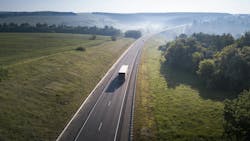Key takeaways
- AI and predictive analytics are shifting fleet safety from reactive responses to proactive, real-time prevention.
- Integrating data from vehicles, drivers, and environments is key to reducing risks and improving decision-making.
- Fleets that adopt connected, AI-driven systems will gain a safety and efficiency edge in the coming decade.
As we approach the second half of the 2020s, FleetOwner asked some of the leading fleet technology providers what they think will be the most game-changing shifts in commercial vehicle safety over the next five years—and how those companies plan to stay ahead of the curve. Answers have been edited for clarity.
Bendix: Mike Tober, North America chief technology officer
The most game-changing shift will be continued improvements in advanced driver assistance system object detection and classification, enabling ADAS to mitigate a wider set of collision scenarios. Looking to the future, Bendix will leverage recent advancements in perception and object classification for highly automated driving (HAD) Level 2+ through Level 4 vehicles, and apply them at a large scale to Level 1 and Level 2 ADAS systems, including AI-based training and verification.
Regardless of the advancements, it's essential to remember that advanced technologies complement safe driving practices. No commercial vehicle safety technology, including Bendix safety technologies, can replace a skilled, alert driver exercising safe driving techniques and undergoing proactive, comprehensive driving training. The driver is responsible for the safe operation of the vehicle at all times. Never wait for the system to intervene. Every driver should carefully review the operator’s manual and receive training from the fleet or vehicle owner on the proper operation and limitations of the ADAS system.
Fleetworthy: Martin Murtland, VP of product
From a safety perspective, we have a positive force multiplier on the horizon that combines creative safety managers with smart technologies. The combination will have a significant impact on the safety of commercial vehicles.
At Fleetworthy, we are enhancing our Safety+ and Smart Roadways offerings with Smart Alerts. We plan to reduce noise in the cab for drivers and eliminate distractions caused by various alerts, pings, and chimes, ensuring that only the right alerts are given at the optimal time. Ensuring our drivers return home safely is our top priority while helping fleets reduce risks, increase efficiency, and grow.
Fleetio: Brianna Perry, product marketing manager
The most transformative shift will be the move from reactive compliance to predictive safety management. Historically, fleets responded to accidents, violations, or breakdowns after the fact. But with connected vehicle data, AI, and integrated systems, safety can increasingly be managed proactively.
We’re already seeing examples of this. One fleet used reporting tools to identify that a specific vehicle type was tied to recurring accidents. By consolidating cost and incident data, they could justify retiring the model and replacing it with safer equipment. We are moving to a future where predictive analytics automatically surface these insights, pinpointing which vehicles or drivers are most likely to pose a safety risk before incidents occur.
Fleetio is focused on bringing maintenance, inspection, telematics, and compliance data into one system, so managers can clearly see risks, act early, and protect both people and assets.
Geotab: Charlie Elliott, SVP of marketing
The most transformative shift in commercial vehicle safety will be the rise of precision AI that supports drivers instantly in the cab. Instead of simply collecting data or reviewing incidents after the fact, these systems will act instantly and intelligently to reduce risk and help prevent accidents before they happen. We’ve all experienced that moment on the road when a distraction occurs—your phone rings, a notification pops up, or you miss a turn. Helping drivers be aware of their actions in these moments will help make our roads safer for everyone.
Geotab is focused on building AI models that continuously improve, learning from billions of data points generated across our global network. The new video intelligence platform evolves automatically with every update, giving fleets sharper, smarter tools without adding administrative work.
Safety technology that actively prevents dangerous situations will soon become the norm. Our new dual-facing AI dashcam, GO Focus Plus, represents that reality, shifting the focus from post-incident review to in-the-moment support. This hardware solution is seamlessly integrated into MyGeotab, providing the best of both worlds: proactive video safety and rich telematics data for a holistic view of fleet operations.
Isaac Instruments: Jean-Sebastien Bouchard, chief product officer and co-founder
As we move into the second half of this decade, the most transformative shift in commercial vehicle safety will be integrating AI into fleet operations. AI is revolutionizing how we interpret and act on data:
- Enabling behavioral detection and coaching on patterns that were previously invisible.
- Supporting predictive maintenance through big data analysis, helping prevent breakdowns and reduce roadside incidents—solutions like Uptake are reducing the number of trucks parked on the road.
- Providing deeper insights into fleet performance, identifying the best and worst-performing vehicles with precision.
Isaac is investing heavily in this future. We have a dedicated AI team focused on developing intelligent products that empower all our customers to operate safer, smarter, and more efficiently.
Motive: Gary Johnson, head of safety and compliance strategy
The biggest shift in commercial vehicle safety over the next five years will be the move from reactive to proactive safety, powered by AI. Instead of investigating accidents after the fact, real-time data from vehicles, drivers, and worksites will help fleets anticipate and prevent incidents while transforming how drivers are trained and coached.
Motive’s AI Dashcams deliver real-time alerts, enabling drivers to correct unsafe behaviors immediately. Meanwhile, safety videos and performance data flow into our Safety Hub for timely coaching and recognition of safe driving.
We’ve taken it a step further with AI models that address critical risks before an accident occurs: Motive’s Lane Swerving Detection flags patterns of swerving over time, and Unsafe Parking Detection alerts managers when vehicles stop in high-risk areas. Fleets using our AI Dashcams have cut collisions by an estimated 80% in the first year. It’s about delivering real-time, context-aware insights that prevent accidents.
Samsara: Johan Land, SVP of product engineering
The most game-changing shift will be from reacting to accidents to actively preventing them at scale through AI. In fact, AI will be the single most transformative technology for road safety, saving more lives over the long term than the invention of the seat belt, antilock brakes, and airbags combined. For too long, the industry has focused on mitigating the severity of accidents through measures such as seat belts and airbags. It’s a paradigm shift from 20/20 hindsight to 20/20 foresight.
At Samsara, we’re harnessing real-world data at scale, with 20 trillion data points covering over 90 billion miles each year. This enables us to apply computer vision and Edge AI with unparalleled precision to prevent accidents from occurring. Edge AI, coupled with a deep understanding of and partnership with physical operations, positions us to give fleet operators a competitive edge in the AI-augmented vehicle safety transformation.
It’s going to fundamentally reshape our roads in the next decade, and we’re proud to partner with fleets on pioneering this safer future with AI-augmented vehicles and the most advanced safety technology.
Solera: Sean Ritchie, VP of sales
The next leap in fleet safety will be a shift in focus—from looking inward at the driver to looking outward at the environment surrounding them.
For the past decade, safety technology has focused on driver behavior, including speeding, following distance, and seat belt use. But as AI matures and autonomous technologies evolve, the bigger risk factors won’t come from inside the cab. They’ll come from the road ahead: other drivers, construction zones, weather patterns, detours, and congestion events.
Sometimes the best way to make a delivery route safer isn’t to coach the driver more but to choose a safer route altogether.
Imagine a platform that recognizes a stretch of highway as high-risk based on patterns across thousands of vehicles and suggests a safer route while the load is still in dispatch, allotting time to ensure the delivery still meets customer expectations. That’s not just risk detection; that’s risk prevention.
To deliver that future, three ingredients are required:
- Data: Solera’s proprietary data lake holds over 5 petabytes of insights across the vehicle life cycle, built over 40-plus years in the industry.
- Ethical AI infrastructure: Our AI is matured through intentional human intelligence, continuously verifying model performance and ensuring fairness, transparency, and accuracy.
- Operational connectivity: The Solera Fleet Platform unites safety, telematics, routing, compliance, and asset management—not siloed tools, but an integrated, natively connected ecosystem feeding real-time data directly into the AI for multi-factor processing.
The result is a fleet that doesn’t just respond to events but anticipates risk, plans around it, and optimizes operations from the point of order all the way to delivery.
Zonar: Jason Craven, chief technology officer
The next major shift in commercial vehicle safety is happening now, driven by predictive analytics and AI. Fleets that can anticipate risks rather than react to them will experience fewer accidents, less unplanned downtime, and lower operational costs. This shift isn’t just about reading and storing the data; it’s about transforming that data into proactive decision-making.
Zonar is at the forefront of this shift through AI-powered video detection tools, such as Zonar Coach and, more recently, Zonar Ignition, its integrated cloud-based platform. With AI-powered event detection, including advanced driver-assistance systems (ADAS) and driver monitoring systems (DMS), combined with real-time in-cab coaching and behavioral analysis, operators can make informed decisions. An open API and the ability to create sophisticated custom reporting, such as accident reconstruction reports, enable fleets to fully leverage their data, integrate insights across systems, and continuously improve safety outcomes. By translating predictive insights into proactive action, Zonar helps fleets move from reactive operations to strategic, data-driven decision making.
About the Author
Josh Fisher
Editor-in-Chief
Editor-in-Chief Josh Fisher has been with FleetOwner since 2017. He covers everything from modern fleet management to operational efficiency, artificial intelligence, autonomous trucking, alternative fuels and powertrains, regulations, and emerging transportation technology. Based in Maryland, he writes the Lane Shift Ahead column about the changing North American transportation landscape.



